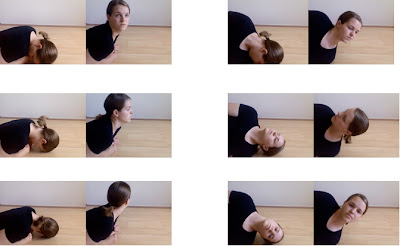Use repetitions.
Be gentle. Be careful. Be patient.
How to strengthen your neck 360
Slowly go from low to high as you do each exercise. do three reps in each position.
These are the exercises to help you strengthen your neck. It is even more affective when you are laying on your bed and your head is hanging off of the side. Make sure you stretch your neck afterward.
Fascia skin rolling
The last images are to help your skin be released. Fasciatis is when the strong wrap around your muscles fibrils, muscles, and your whole body and it gets so tight it feels pinchy when you pull your skin.
Even though it is painful to rub out Fasciatis, (inflammation of the fascia), it is well worth it. It is only after you get rid of the Fasciatis that you can rub out your muslces withot increasing the inflammation.
If you have a swollen body parts you want to follow a simple recipe.
72 hours of a major injury: Ice only
Ice 3 times a day for 20 minutes at most. If you go over this time your body will protect itself by re-heating.
After the three days are over you want to heat it to bring blood to the area in order for the oxygen to heal it.
When you have continued swelling you want to ice up to 20 min, heat up to 30 min (or off 30 min), then ice up to 20 min.
I had Tendonitis, Fasciatis, and Tarsal Tunnel in my left ankle. Notice the past tense. Had. I have discovered much in fighting with this in my body and the antagonistic dancing.
1. I warm up before I stretch or dance
2. Consistently do anaerobic or aerobic exercise (3 days a week: 30 min or less or aerobic benefit, 30+ minutes for weight removal.)
3. stretch and make sure I am cool when I finish
When I do these things the Tendonitis and Tarsal Tunnel don't resurface. Fasciatis (inflammation of the fascia) is one of those things that requires you stretch to release the Colliod (gluey substance in fascia) and/or play with your skin. As explained and pictured above.
Strengthen those muscles all around
Do at least five reps in each direction (preferably ten). Make sure you stretch after finish.
Roll up Psoas and Iliacus isolation
It is very difficult to have a neutral pelvis. The best way to find out if your pelvis is neutral is to mark on the front of your hip (the Anterior Superior Illiac Spine) and the back of your hip (the Posterior Superior Illiac Spine). Then use a straight stick/ruler/level to show if your two Illiac spines are level with each other OR spilling one way or another.
After personal dance accidents and uneducated instructors Kristy recovered from an anterior pelvic tilt only to fall into a posterior pelvic tilt. These exercises, done for two years, have created an equilibrium. Kristy now enjoys a neutral pelvis and less Lumbar pain.
Begin: (Always check with your doctor to make sure your personal body ailments can withstand new exercises. If you're poor? Avoid sharp or needle-like pain. No pain? You gain.)
Start by laying on the ground with your arms to your sides. Raise your knees (like those old fashioned sit-ups) with your feet hip width apart. Check to make sure your back is spread on the floor and your lower ribs are pressing into the floor as well (not raising to the sky).
Now rock your hips back and forth. Anterior, Neutral, Posterior, Neutral, Anterior, etc. Try to keeps your ribs down while doing this.
If this causes pain? STOP! Go to a Chiropractor or Sports Therapist. They have the technology to take X-rays and see what your personal ailment includes. (Sorry to all those doctors...I never had much help from you in this regard.)
From neutral press your lower back into the ground (posterior pelvic tilt). Lengthen the angle from your hip to your thigh. slowly roll up to a plank position. Do this one vertebrae at a time. You can use the image of your hips trying to reach the top and your ribs being too comfortable with the floor to comply easily.
When your reach the plank or diagonal hold it there for a few seconds. Make sure that your back is not curved to the sky. If it is you went too far. Your body should be flat like a board.







